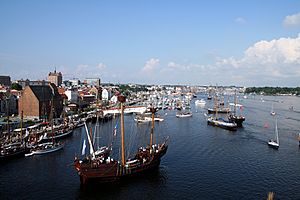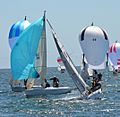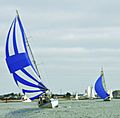Sailing facts for kids


Sailing is the craft of controlling a boat that uses the force of the wind as a source of movement. Sailing boats were very important to move cargo and people. Starting at the end of the 19th century they were gradually replaced by the boats that used steam to generate motion. Today, sailing is a hobby some people have. In some regions of the world, sailing vessels still keep their importance. Many military forces also have sailing vessels for the purpose of training.
Sailing is also a competitive sport. It is one of the sports in the Olympic Games.
Images for kids
-
Fijian voyaging outrigger boat with a crab claw sail
-
Replica of Christopher Columbus's carrack, Santa María under sail
-
A late-19th-century American clipper ship
-
Cruising sailing yacht at anchor in Duck Harbor on Isle au Haut, Maine
-
Comanche leaving Newport, Rhode Island for Plymouth, England in the 2015 Rolex Transatlantic Race
-
Points of sail (and predominant sail force component for a displacement sailboat). A. Luffing (no propulsive force) — 0-30° B. Close-hauled (lift)— 30–50° C. Beam reach (lift)— 90° D. Broad reach (lift–drag)— ~135° E. Running (drag)— 180° True wind (VT) is the same everywhere in the diagram, whereas boat velocity (VB) and apparent wind (VA) vary with point of sail.
-
The ocean currents
-
Spinnakers are adapted for sailing off the wind.
-
Aerodynamic force components for two points of sail. Left-hand boat: Down wind with detached airflow like a parachute— predominant drag component propels the boat with little heeling moment. Right-hand boat: Up wind (close-hauled) with attached airflow like a wing—predominant lift component both propels the boat and contributes to heel.
See also
 In Spanish: Navegación a vela para niños
In Spanish: Navegación a vela para niños

























